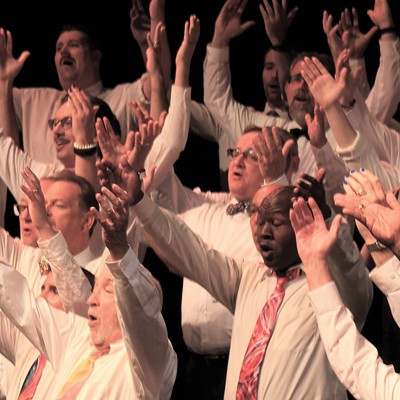"What do you see?"
These are the first words of John Logan's Tony Award-winning play Red, now onstage here courtesy of the Arizona Theatre Company. It's a pleasing finale to the company's 2011-2012 season.
The question is posed by Denis Arndt as he portrays Mark Rothko, the painter known for his huge canvas panels featuring blocks of color, which are generally characterized as abstract expressionism. Arndt stares into the space above our heads, peering through that permeable fourth wall on which we imagine hangs one of Rothko's paintings. The painter is intent, searching. As we witness the passion with which he interacts with his painting, we can see not only the life he has invested in this work, but also the way it returns life to him in a continual cycle of animation.
In some ways, Red is a very quiet play. There is no easily discernible conflict that drives the action; it's propelled mostly by the passage of time and the evolving relationship between Rothko and his assistant. But the play is loud with ideas, largely about art: what it does; its often curious place in culture; its seriousness and—conversely—its sometimes inflated importance; the tentative, if not downright hostile, reception it often receives from the public; and the passion of the artist and his commitment to creation, even in the presence of self-doubt, often disguised by an inflated ego.
Because these ideas unfold within a plausible context, grounded in the life and work of Rothko, the play rises above being merely a contrivance, an excuse to talk about art.
But neither is Red a biographical story, although we do learn plenty about Rothko. Rather, Logan uses Rothko—his genius, his arrogance, his attempt to deal with his place in the evolving world of art—as our entry into the world and work of an artist. For those who love art and enjoy lively discussions about it, this play is an absolute delight.
The setup is simple: It's 1958. Rothko has hired an assistant, Ken (Connor Toms), to help facilitate the completion of the largest commission in the history of modern art: panels to adorn the walls of the soon-to-open Four Seasons restaurant in New York, owned by the Joseph E. Seagram and Sons Co. At 40 huge panels, it is a massive undertaking; it is also a massive irony. Although Seagram didn't dictate the nature or details of the paintings, the fact that Rothko's work was to adorn the walls of a fancy-schmancy temple of consumption contradicted what Rothko declared he wanted his work to be, and what he wanted it to do. It was never meant to be décor; it was to live and breathe in the consciousness of the viewer. How could this be possible in the chatty confines of an upscale restaurant?
This irony is not lost on Rothko, although he largely seems to be able to ignore it. As he says, "Artists should starve—except me." But during the two years Rothko and his assistant spend together, Ken, an artist himself, challenges Rothko, perceiving that the great artist is selling out, especially since Rothko has been so bombastic in declaring his ideas about what he wants his art to be. "I'm here to stop your heart and make you think; I'm not here to make pretty pictures," Rothko declares. He scoffs at Ken's fascination with the new artists making an impact: Pollock, Warhol and Lichtenstein. He berates Ken for what he feels is his total lack of preparation for becoming an artist, or even appreciating art. Ken has not read Nietzsche and Jung and Freud, so he doesn't even know how to look at Rothko's paintings. "Meet it halfway," Rothko charges. "Argue with them; grapple with them; but don't understand them."
But we can see that Ken pokes at Rothko's demons when the artist admits, referring to the paintings he is creating, that he fears the black will swallow the red one day, and that when he is weighed in the balance, he will be found wanting.
To make this drama work, the actors portraying these two must be strong enough to carry the show, and ATC's production features fine performances from both Arndt and Toms. Toms initially overreaches, "acting" a bit too obviously, although we do warm up to him as the story progresses. His over-the-top approach seems even more pronounced in comparison to Arndt's quiet, well-grounded characterization, in which Arndt is Rothko; there's never a moment in which we doubt his credibility. Even though a bit abrasive and thoroughly self-absorbed, there is a softness in Arndt's Rothko. The character is not always portrayed this way, and it actually makes him more sympathetic, more likable. It's not a bad choice.
Director Richard E.T. White does a fine job of putting the elements of the production together for a tight 90 minutes of nonstop, thought-provoking activity. ("Action" is too strong of a word for this story.) There is a wonderful scene in which the two prime a canvas; it's a gleefully choreographed dance executed energetically by Toms and Arndt. ATC veteran Kent Dorsey's set—Rothko's New York studio—is impressive in an understated way; it's almost a character itself. The likenesses of Rothko's work were used with permission from Rothko's children, Kate Rothko Prizel and Christopher Rothko.
I'm sure there will be plenty of puns about ATC wanting us to see red. But if you enjoy intelligent exchanges about art and appreciate a well-executed piece of theater, you should check this show out. It's a well-wrought piece sure to excite those who are passionate about art, and who wish to enhance their understanding about the relationship between the work and the people who produce it.









